 The development of open-source software and blockchain technology has enabled people to ‘hack’ capitalism – to present and provide alternatives to traditional modes of production, consumption and exchange. This has enabled more effective markets in second-hand products, new environmentally-friendly technologies and by-products that otherwise would have been negative externalities. Cryptocurrencies are increasingly providing the medium of exchange in such markets.
The development of open-source software and blockchain technology has enabled people to ‘hack’ capitalism – to present and provide alternatives to traditional modes of production, consumption and exchange. This has enabled more effective markets in second-hand products, new environmentally-friendly technologies and by-products that otherwise would have been negative externalities. Cryptocurrencies are increasingly providing the medium of exchange in such markets.
In a BBC podcast, Hacking Capitalism, Leo Johnson, head of PwC’s Disruption Practice and younger brother of Boris Johnson, argues that various changes to the way capitalism operates can make it much more effective in improving the lives of everyone, including those left behind in the current world. The changes can help address the failings of capitalism, such as climate change, environmental destruction, poverty and inequality, corruption, a reinforcement of economic and political power and the lack of general access to capital. And these changes are already taking place around the world and could lead to a new ‘golden age’ for capitalism.
 The changes are built on new attitudes and new technologies. New attitudes include regarding nature and the land as living resources that need respect. This would involve moving away from monocultures and deforestation and, with appropriate technologies (old and new), could lead to greater output, greater equality within agriculture and increased carbon absorption. The podcast gives examples from the developing and developed world of successful moves towards smaller-scale and more diversified agriculture that are much more sustainable. The rise in farmers’ markets provides an important mechanism to drive both demand and supply.
The changes are built on new attitudes and new technologies. New attitudes include regarding nature and the land as living resources that need respect. This would involve moving away from monocultures and deforestation and, with appropriate technologies (old and new), could lead to greater output, greater equality within agriculture and increased carbon absorption. The podcast gives examples from the developing and developed world of successful moves towards smaller-scale and more diversified agriculture that are much more sustainable. The rise in farmers’ markets provides an important mechanism to drive both demand and supply.
In the current model of capitalism there are many barriers to prevent the poor from benefiting from the system. As the podcast states, there are some 2 billion people across the world with no access to finance, 2.6 billion without access to sanitation, 1.2 billion without access to power – a set of barriers that stops capitalism from unlocking the skills and productivity of the many.
 These problems were made worse by the response to the financial crisis of 2007–8, when governments chose to save the existing model of capitalism by propping up financial markets through quantitative easing, which massively inflated asset prices and aggravated the problem of inequality. They missed the opportunity of creating money to invest in alternative technologies and infrastructure.
These problems were made worse by the response to the financial crisis of 2007–8, when governments chose to save the existing model of capitalism by propping up financial markets through quantitative easing, which massively inflated asset prices and aggravated the problem of inequality. They missed the opportunity of creating money to invest in alternative technologies and infrastructure.
New technology is the key to developing this new fairer, more sustainable model of capitalism. Such technologies could be developed (and are being in many cases) by co-operative, open-source methods. Many people, through these methods, could contribute to the development of products and their adaptation to meet different needs. The barriers of intellectual property rights are by-passed.
New technologies that allow easy rental or sharing of equipment (such as tractors) by poor farmers can transform lives and massively increase productivity. So too can the development of cryptocurrencies to allow access to finance for small farmers and businesses. This is particularly important in countries where access to traditional finance is restricted and/or where the currency is not stable with high inflation rates.
Blockchain technology can also help to drive second-hand markets by providing greater transparency and thereby cut waste. Manufacturers could take a stake in such markets through a process of certification or transfer.
 A final hack is one that can directly tackle the problem of externalities – one of the greatest weaknesses of conventional capitalism. New technologies can support ways of rewarding people for reducing external costs, such as paying indigenous people for protecting the land or forests. Carbon markets have been developed in recent years. Perhaps the best example is the European Emissions Trading Scheme (EMS). But so far they have been developed in isolation. If the revenues generated could go directly to those involved in environmental protection, this would help further to internalise the externalities. The podcasts gives an example of a technology used in the Amazon to identify the environmental benefits of protecting rain forests that can then be used to allow reliable payments to the indigenous people though blockchain currencies.
A final hack is one that can directly tackle the problem of externalities – one of the greatest weaknesses of conventional capitalism. New technologies can support ways of rewarding people for reducing external costs, such as paying indigenous people for protecting the land or forests. Carbon markets have been developed in recent years. Perhaps the best example is the European Emissions Trading Scheme (EMS). But so far they have been developed in isolation. If the revenues generated could go directly to those involved in environmental protection, this would help further to internalise the externalities. The podcasts gives an example of a technology used in the Amazon to identify the environmental benefits of protecting rain forests that can then be used to allow reliable payments to the indigenous people though blockchain currencies.
Podcast
Questions
- What are the main reasons why capitalism has led to such great inequality?
- What do you understand by ‘hacking’ capitalism?
- How is open-source software relevant to the development of technology that can have broad benefits across society?
- Does the current model of capitalism encourage a self-centred approach to life?
- How might blockchain technology help in the development of a more inclusive and fairer form of capitalism?
- How might farmers’ co-operatives encourage rural development?
- What are the political obstacles to the developments considered in the podcast?
 For those of you embarking on a course in economics, one of the first things you’ll come across is the distinction between microeconomics and macroeconomics. The news is full of both microeconomic and macroeconomic issues and you’ll quickly see how relevant both branches of economics are to analysing real-world events, problems and policies.
For those of you embarking on a course in economics, one of the first things you’ll come across is the distinction between microeconomics and macroeconomics. The news is full of both microeconomic and macroeconomic issues and you’ll quickly see how relevant both branches of economics are to analysing real-world events, problems and policies.
As we state in Economics (updated 10th edition), ‘microeconomics is concerned with the individual parts of the economy. It is concerned with the demand and supply of particular goods, services and resources such as cars, butter, clothes, haircuts, plumbers, accountants, blast furnaces, computers and oil.’ In particular, it is concerned with the buying, selling, production and employment decisions of individuals and firms. When you go shopping and make choices of what to buy you are making microeconomic decisions. When firms choose how much of particular products to produce, what techniques of production to use and how many people to employ, these choices are microeconomic ones.
 Microeconomics examines people’s behaviour when they make choices. In fact many of the recent developments in microeconomics involve analysing the behaviour of individuals and firms and the factors that influence this behaviour.
Microeconomics examines people’s behaviour when they make choices. In fact many of the recent developments in microeconomics involve analysing the behaviour of individuals and firms and the factors that influence this behaviour.
Open any newspaper, turn on the TV news or access any news site and you will see various microeconomic issues covered. Why are rents soaring? How is AI affecting various businesses’ productivity? How rapidly is the switch taking place to green energy? How do supermarkets influence spending patterns? Why are wages so low in the social care sector? Why are private PCR tests so expensive for holidaymakers retuning from abroad?
Many of the blogs on this news site will examine microeconomic issues. We hope that they provide useful case studies for your course.
Articles
Questions
- Look through news sites and identify five current microeconomic issues. What makes them ‘micro’ issues?
- If world oil and gas prices rise, why is this a microeconomic issue?
- What do you understand by ‘scarcity’? How is microeconomics related to scarcity?
- Are all goods scarce?
- What is meant by ‘opportunity cost’? Give some examples of how opportunity cost has affected recent decisions you have made.
 The coronavirus pandemic and the climate emergency have highlighted the weaknesses of free-market capitalism.
The coronavirus pandemic and the climate emergency have highlighted the weaknesses of free-market capitalism.
Governments around the world have intervened massively to provide economic support to people and businesses affected by the pandemic through grants and furlough schemes. They have also stressed the importance of collective responsibility in abiding by lockdowns, social distancing and receiving vaccinations.
The pandemic has also highlighted the huge inequalities around the world. The rich countries have been able to offer much more support to their people than poor countries and they have had much greater access to vaccines. Inequality has also been growing within many countries as rich people have gained from rising asset prices, while many people find themselves stuck in low-paid jobs, suffering from poor educational opportunities and low economic and social mobility.
The increased use of working from home and online shopping has accelerated the rise of big tech companies, such as Amazon and Google. Their command of the market makes it difficult for small companies to compete – and competition is vital if capitalism is to benefit societies. There have been growing calls for increased regulation of powerful companies and measures to stimulate competition. The problem has been recognised by governments, central banks and international agencies, such as the IMF and the OECD.
 At the same time as the world has been grappling with the pandemic, global warming has contributed to extreme heat and wildfires in various parts of the world, such as western North America, the eastern Mediterranean and Siberia, and major flooding in areas such as western Europe and China. Governments again have intervened by providing support to people whose property and livelihoods have been affected. Also there is a growing urgency to tackle global warming, with some movement, albeit often limited, in implementing policies to achieve net zero carbon emissions by some specified point in the future. Expectations are rising for concerted action to be agreed at the international COP26 climate meeting in Glasgow in November this year.
At the same time as the world has been grappling with the pandemic, global warming has contributed to extreme heat and wildfires in various parts of the world, such as western North America, the eastern Mediterranean and Siberia, and major flooding in areas such as western Europe and China. Governments again have intervened by providing support to people whose property and livelihoods have been affected. Also there is a growing urgency to tackle global warming, with some movement, albeit often limited, in implementing policies to achieve net zero carbon emissions by some specified point in the future. Expectations are rising for concerted action to be agreed at the international COP26 climate meeting in Glasgow in November this year.
An evolving capitalism
So are we seeing a new variant of capitalism, with a greater recognition of social responsibility and greater government intervention?
 Western governments seem more committed to spending on socially desirable projects, such as transport, communications and green energy infrastructure, education, science and health. They are beginning to pursue more active industrial and regional policies. They are also taking measures to tax multinationals (see the blog The G7 agrees on measures to stop corporate tax avoidance). Many governments are publicly recognising the need to tackle inequality and to ‘level up’ society. Active fiscal policy, a central plank of Keynesian economics, has now come back into fashion, with a greater willingness to fund expenditure by borrowing and, over the longer term, to use higher taxes to fund increased government expenditure.
Western governments seem more committed to spending on socially desirable projects, such as transport, communications and green energy infrastructure, education, science and health. They are beginning to pursue more active industrial and regional policies. They are also taking measures to tax multinationals (see the blog The G7 agrees on measures to stop corporate tax avoidance). Many governments are publicly recognising the need to tackle inequality and to ‘level up’ society. Active fiscal policy, a central plank of Keynesian economics, has now come back into fashion, with a greater willingness to fund expenditure by borrowing and, over the longer term, to use higher taxes to fund increased government expenditure.
But there is also a growing movement among capitalists themselves to move away from profits being their sole objective. A more inclusive ‘stakeholder capitalism’ is being advocated by many companies, where they take into account the interests of a range of stakeholders, from customers, to workers, to local communities, to society in general and to the environment. For example, the Council for Inclusive Capitalism, which is a joint initiative of the Vatican and several world business and public-sector leaders, seeks to make ‘the world fairer, more inclusive, and sustainable’.
If there is to be a true transformation of capitalism from the low-tax free-market capitalism of neoclassical economists and libertarian policymakers to a more interventionist mixed market capitalism, where capitalists pursue a broader set of objectives, then words have to be matched by action. Talk is easy; long-term plans are easy; taking action now is what matters.
Articles and videos
- Why the next stage of capitalism is coming
BBC Future, Matthew Wilburn King (27/5/21)
- During the pandemic, a new variant of capitalism has emerged
The Guardian, Larry Elliott (30/7/21)
- When it comes to social and environmental justice, words don’t cut it
GreenBiz, C J Clouse (28/4/21)
 Introducing the Council for Inclusive Capitalism with the Vatican
Introducing the Council for Inclusive Capitalism with the VaticanInclusive Capitalism (7/12/20)
- The State and Direction of Inclusive Capitalism
Saïd Business School, Ford Foundation and Deloitte Social Impact practice, Richard Barker, Mary Johnstone-Louis, Colin Mayer, Pradeep Prabhala, Noah Rimland Flower, Theodore Roosevelt Malloch, Tony Siesfeld and Peter Tufano (2018)
- Rising Market Power—A Threat to the Recovery?
IMF Blog, Kristalina Georgieva, Federico J Díez, Romain Duval and Daniel Schwarz (15/3/21)
- The Pandemic Alone Can’t Transform Capitalism
Jacobin, Ramaa Vasudevan (30/7/21)
- Down to earth: How entrepreneurs can collaborate to rejuvenate capitalism
EU-Startups, Luca Sabia (4/8/21)
Questions
- How similar is the economic response of Western governments to the pandemic to their response to the financial crisis of 2007–8?
- What do you understand by ‘inclusive capitalism’? How can stakeholders hold companies to account?
- What indicators are there of market power? Why have these been on the rise?
- How can entrepreneurs contribute to ‘closing the inequality gap for a more sustainable and inclusive form of society’?
- What can be done to hold governments to account for meeting various social and environmental objectives? How successful is this likely to be?
- Can inequality be tackled without redistributing income and wealth from the rich to the poor?
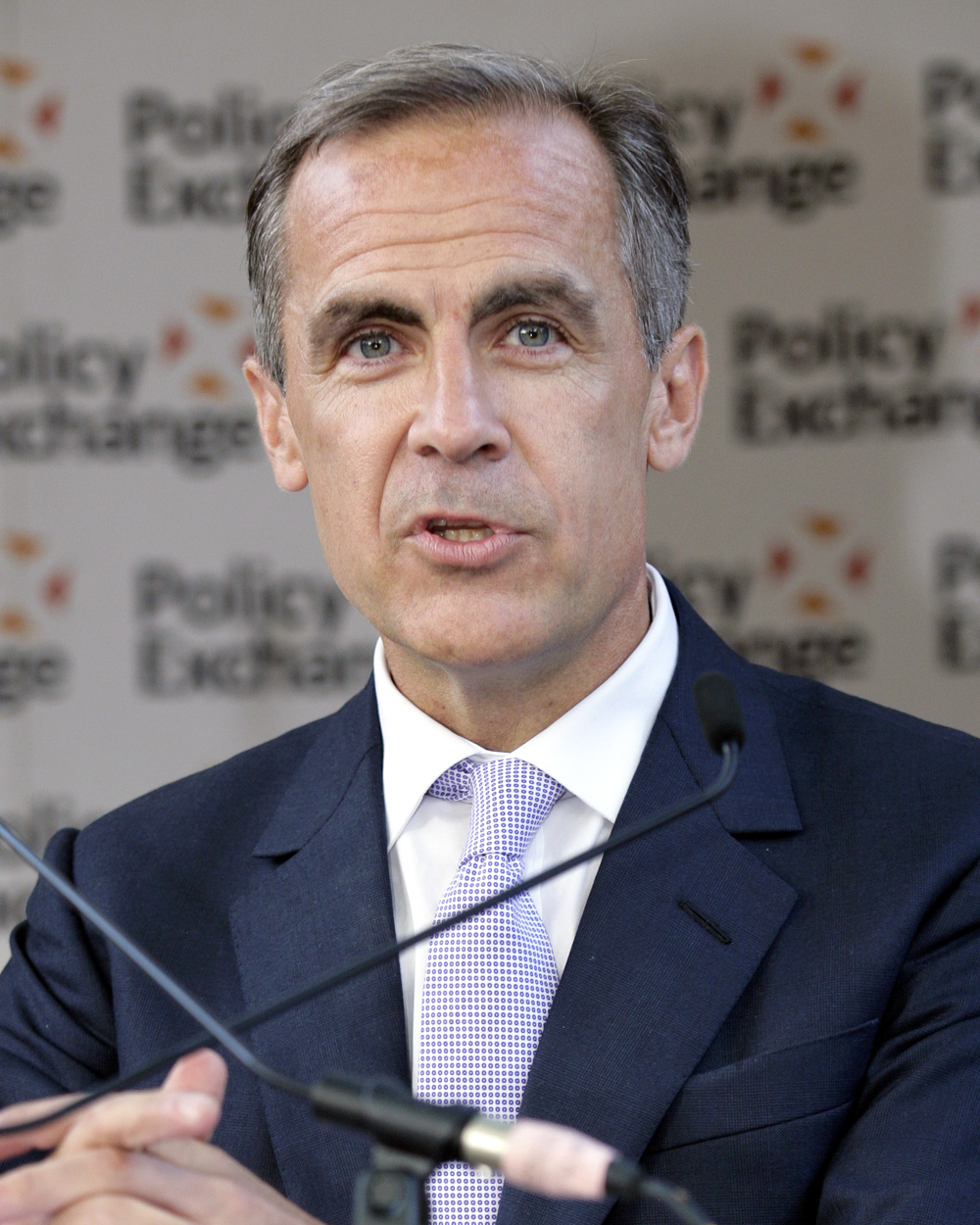 Each year the BBC hosts the Reith Lectures – a series of talks given by an eminent person in their field. This year’s lecturer is Mark Carney, former Governor of the Bank of England. His series of four weekly lectures began on 2 December 2020. Their topic is ‘How we get what we value’. As the BBC site states, the lectures:
Each year the BBC hosts the Reith Lectures – a series of talks given by an eminent person in their field. This year’s lecturer is Mark Carney, former Governor of the Bank of England. His series of four weekly lectures began on 2 December 2020. Their topic is ‘How we get what we value’. As the BBC site states, the lectures:
chart how we have come to esteem financial value over human value and how we have gone from market economies to market societies. He argues that this has contributed to a trio of crises: of credit, Covid and climate. And the former Bank of England governor will outline how we can turn this around.
 In lectures 2, 3 and 4, he looks at three crises and how they have shaped and are shaping what we value. The crises are the financial crisis of 2007–9, the coronavirus pandemic and the climate crisis. They have challenged how we value money, health and the environment respectively and, more broadly, have prompted people to question what is valuable for individuals and society, both today and into the future.
In lectures 2, 3 and 4, he looks at three crises and how they have shaped and are shaping what we value. The crises are the financial crisis of 2007–9, the coronavirus pandemic and the climate crisis. They have challenged how we value money, health and the environment respectively and, more broadly, have prompted people to question what is valuable for individuals and society, both today and into the future.
The questions posed by Carney are how can we establish what is valuable to individuals and society, how well are such values met by economies and how can mechanisms be improved to ensure that we make the best use of resources in meeting those values.
Value and the market
In the first lecture he probes the concept of value. He explores how economists and philosophers have tried to value the goods, services and human interactions that we desire.
First there is ‘objective value’ propounded by classical economists, such as Adam smith, David Ricardo and Karl Marx. Here the value of goods and services depends on the amount of resources used to make them and fundamentally on the amount of labour. In other words, value is a supply-side concept.
This he contrasts with ‘subjective value’. Here the value of goods and services depends on how well they satisfy wants – how much utility they give the consumer. For these neoclassical economists, value is in the eye of the beholder; it is a demand-side concept.
The two are reconciled in the market, with market prices reflecting the balance of demand and supply. Market prices provided a solution to the famous diamonds/water paradox (see Box 4.2 in Economics (10th edition) or Case Study 4.3 in Essentials of Economics (8th edition) – the paradox of ‘why water, which is essential for life, is virtually free, but diamonds, which have limited utility beyond their beauty, are so expensive.’ The answer is to do with scarcity and marginal utility. Because diamonds are rare, the marginal utility is high, even though the total utility is low.  And because water is abundant, even though its total utility is high, for most people its marginal utility is low. In other words, the value at the margin depends on the balance of demand and supply. Diamonds are much scarcer than water.
And because water is abundant, even though its total utility is high, for most people its marginal utility is low. In other words, the value at the margin depends on the balance of demand and supply. Diamonds are much scarcer than water.
But is the market balance the right balance? Are the values implied by the market the same as those of society? ‘Why do financial markets rate Amazon as one of the world’s most valuable companies, but the value of the vast region of the Amazon appears on no ledger until it’s stripped of its foliage and converted into farmland?’ – another paradox highlighted by Carney.
It has long been recognised that markets fail in a number of ways. They are not perfect, with large firms able to make supernormal profits by charging more and producing less, and consumers often being ill-informed and behaving impulsively or being swayed by clever marketing. And many valuable things that we experience, such as human interaction and the beauty of nature, are not bought and sold and thus do not appear in measures of GDP – one of the main ways of valuing a country.
 What is more, many of things that are produced in the market have side-effects which are not reflected in prices. These externalities, whether good or bad, can be substantial: for example, the global warming caused by CO2 emissions from industry, transport and electricity production from fossil fuels.
What is more, many of things that are produced in the market have side-effects which are not reflected in prices. These externalities, whether good or bad, can be substantial: for example, the global warming caused by CO2 emissions from industry, transport and electricity production from fossil fuels.
And markets reflect people’s biases towards the present and hence lead to too little investment for the future, whether in healthcare, the environment or physical and social infrastructure. Markets reflect the scant regard many give to the damage we might be doing to the lives of future generations.
What is particularly corrosive, according to Carney, is the
drift from moral to market sentiments. …Increasingly, the value of something, some act or someone is equated with its monetary value, a monetary value that is determined by the market. The logic of buying and selling no longer applies only to material goods, but increasingly it governs the whole of life from the allocation of healthcare, education, public safety and environmental protection. …Market value is taken to represent intrinsic value, and if a good or activity is not in the market, it is not valued.
The drift from moral to market sentiments accelerated in the Thatcher/Regan era, when governments were portrayed as inefficient allocators, which stifled competition, innovation and the movement of capital. Deregulation and privatisation were the order of the day. This, according to Carney, ‘unleashed a new dynamism’ and ‘with the fall of communism at the end of the 1980s, the spread of the market grew unchecked.’
But this drift failed to recognise market failures. It has taken three crises, the financial crisis, Covid and the climate crisis to bring these failures to the top of the public agenda. They are examined in the other three lectures.
The Reith Lectures
Questions
- Distinguish between objective and subjective value.
- If your income rises, will you necessarily be happier? Explain.
- How is the concept of diminishing marginal utility of income relevant to explaining why ‘A Christmas bonus of £1000 means less to Mark Zuckerberg then £500 does to someone on a minimum wage.’
- Does the use of social cost–benefit analysis enable us to use adjusted prices as a measure of value?
- Listen to lectures 2, 3 and 4 and provide a 500-word summary of each.
- Assess the arguments Mark Carney uses in one of these three lectures.
 Share prices are determined by demand and supply. The same applies to stock market indices, such as the FTSE 100 and FTSE 250 in the UK and the Dow Jones Industrial Average and the S&P 500 in the USA. After all, the indices are the weighted average prices of the shares included in the index. Generally, when economies are performing well, or are expected to do so, share prices will rise. They are likely to fall in a recession or if a recession is anticipated. A main reason for this is that the dividends paid on shares will reflect the profitability of firms, which tends to rise in times of a buoyant economy.
Share prices are determined by demand and supply. The same applies to stock market indices, such as the FTSE 100 and FTSE 250 in the UK and the Dow Jones Industrial Average and the S&P 500 in the USA. After all, the indices are the weighted average prices of the shares included in the index. Generally, when economies are performing well, or are expected to do so, share prices will rise. They are likely to fall in a recession or if a recession is anticipated. A main reason for this is that the dividends paid on shares will reflect the profitability of firms, which tends to rise in times of a buoyant economy.
When it first became clear that Covid-19 would become a pandemic and as countries began locking down, so stock markets plummeted. People anticipated that many businesses would fail and that the likely recession would cause profits of many other surviving firms to decline rapidly. People sold shares.
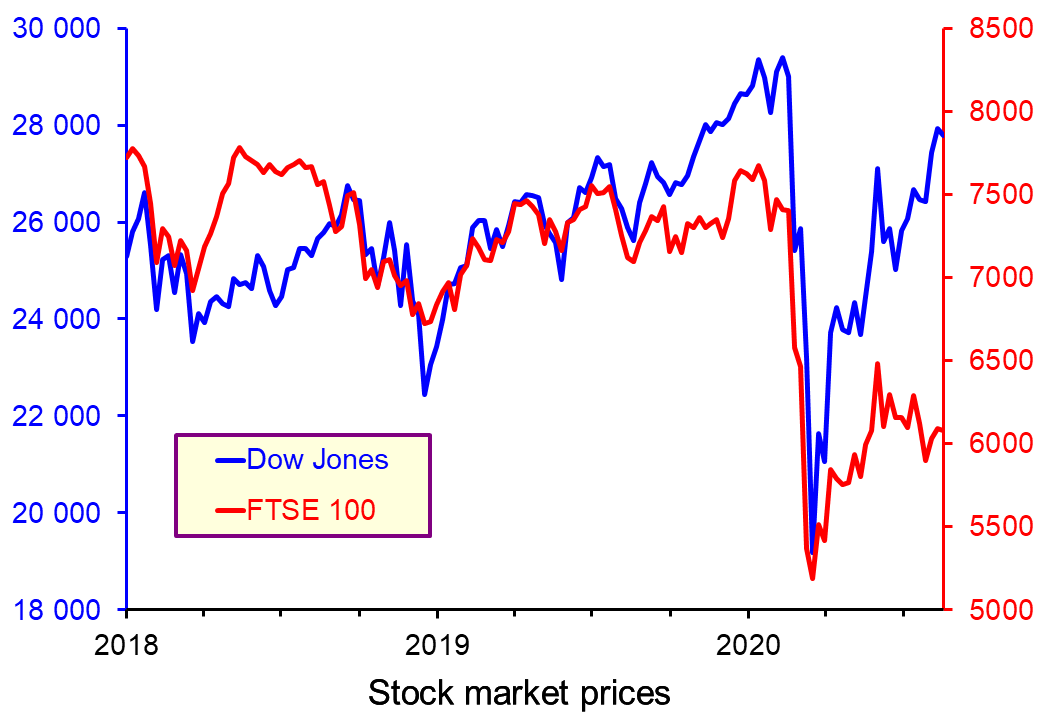 The first chart shows how the FTSE 100 fell from 7466 in early February 2020 to 5190 in late March, a fall of 30.5%. The Dow Jones fell by 34% over the same period. In both cases the fall was driven not only by the decline in the respective economy over the period, but by speculation that further declines were to come (click here for a PowerPoint of the chart).
The first chart shows how the FTSE 100 fell from 7466 in early February 2020 to 5190 in late March, a fall of 30.5%. The Dow Jones fell by 34% over the same period. In both cases the fall was driven not only by the decline in the respective economy over the period, but by speculation that further declines were to come (click here for a PowerPoint of the chart).
But then stock markets started rising again, especially the Dow Jones, despite the fact that the recessions in the UK, the USA and other countries were gathering pace. In the second quarter of 2020, the Dow Jones rose by 23% and yet the US economy declined by 33% – the biggest quarterly decline on record. How could this be explained by supply and demand?
Quantitative easing
In order to boost aggregate demand and reduce the size of the recession, central banks around the world engaged in large-scale quantitative easing. 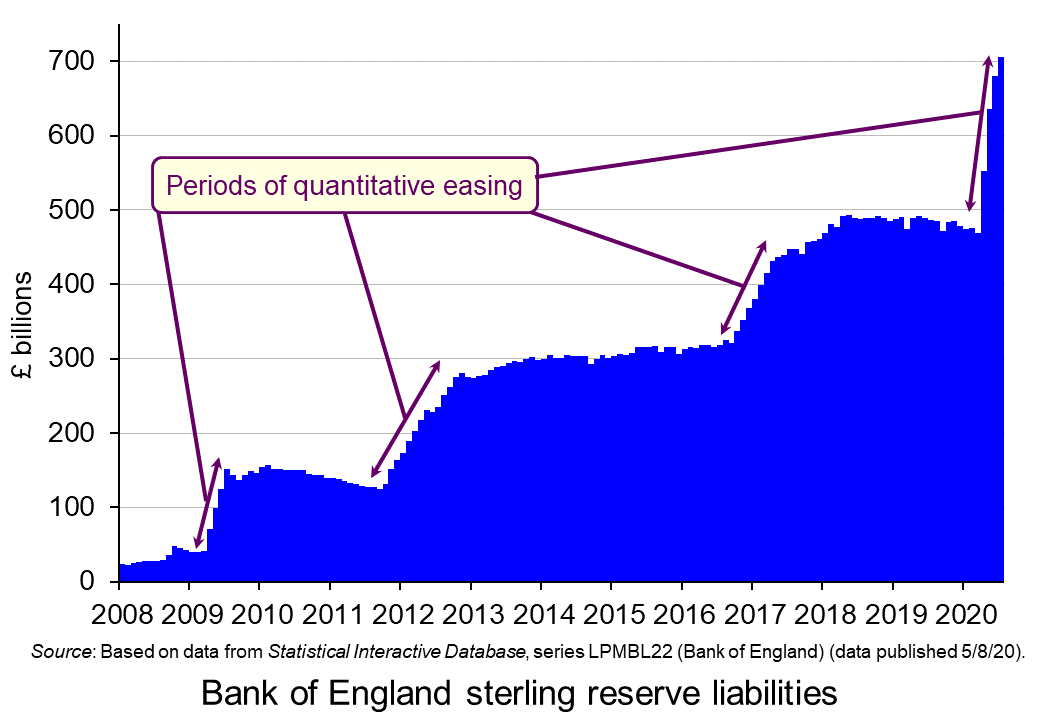 This involves central banks buying government bonds and possibly corporate bonds too with newly created money. The extra money is then used to purchase other assets, such as stocks and shares and property, or physical capital or goods and services. The second chart shows that quantitative easing by the Bank of England increased the Bank’s asset holding from April to July 2020 by 50%, from £469bn to £705bn (click here for a PowerPoint of the chart).
This involves central banks buying government bonds and possibly corporate bonds too with newly created money. The extra money is then used to purchase other assets, such as stocks and shares and property, or physical capital or goods and services. The second chart shows that quantitative easing by the Bank of England increased the Bank’s asset holding from April to July 2020 by 50%, from £469bn to £705bn (click here for a PowerPoint of the chart).
But given the general pessimism about the state of the global economy, employment and personal finances, there was little feed-through into consumption and investment. Instead, most of the extra money was used to buy assets. This gave a huge boost to stock markets. Stock market movements were thus out of line with movements in GDP.
Confidence
Stock market prices do not just reflect the current economic and financial situation, but also what people anticipate the situation to be in the future. 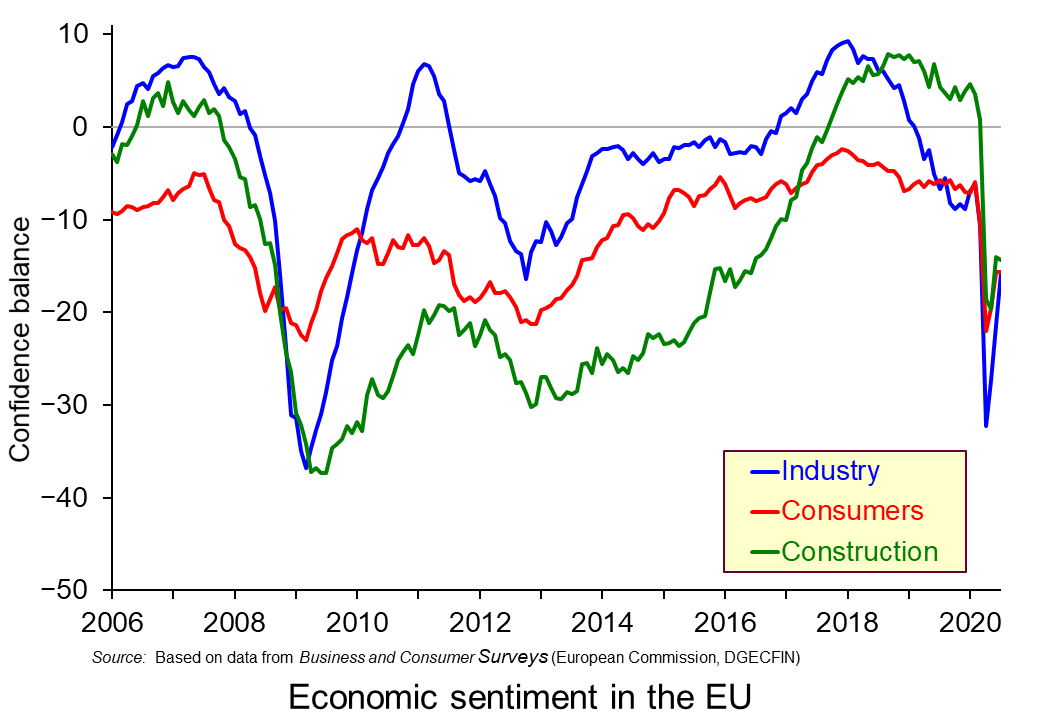 As infection and death rates from Covid-19 waned around Europe and in many other countries, so consumer and business confidence rose. This is illustrated in the third chart, which shows industrial, consumer and construction confidence indicators in the EU. As you can see, after falling sharply as the pandemic took hold in early 2020 and countries were locked down, confidence then rose (click here for a PowerPoint of the chart).
As infection and death rates from Covid-19 waned around Europe and in many other countries, so consumer and business confidence rose. This is illustrated in the third chart, which shows industrial, consumer and construction confidence indicators in the EU. As you can see, after falling sharply as the pandemic took hold in early 2020 and countries were locked down, confidence then rose (click here for a PowerPoint of the chart).
But, as infection rates have risen somewhat in many countries and continue to soar in the USA, Brazil, India and some other countries, this confidence may well start to fall again and this could impact on stock markets.
Speculation
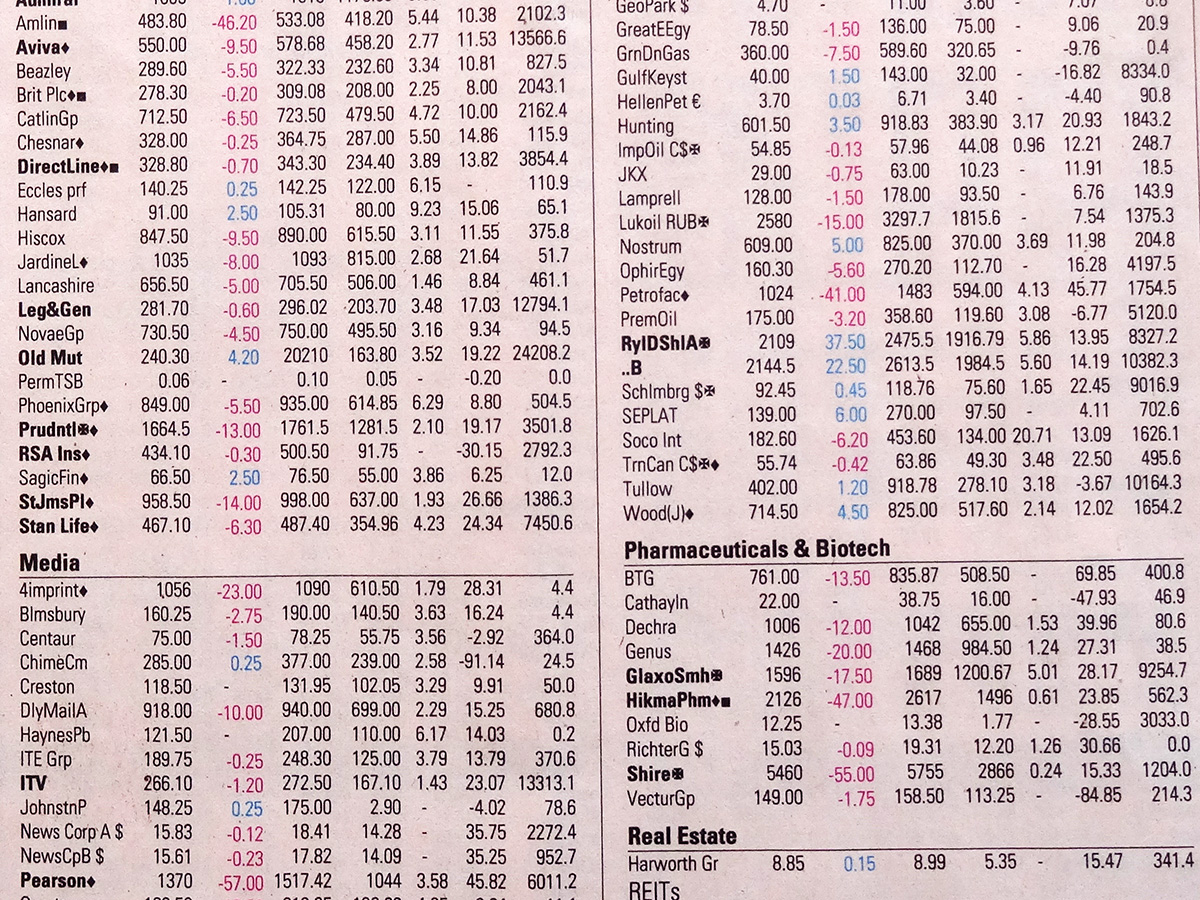 A final, but related, cause of recent stock market movements is speculation. If people see share prices falling and believe that they are likely to fall further, then they will sell shares and hold cash or safer assets instead. This will amplify the fall and encourage further speculation. If, however, they see share prices rising and believe that they will continue to do so, they are likely to want to buy shares, hoping to make a gain by buying them relatively cheaply. This will amplify the rise and, again, encourage further speculation.
A final, but related, cause of recent stock market movements is speculation. If people see share prices falling and believe that they are likely to fall further, then they will sell shares and hold cash or safer assets instead. This will amplify the fall and encourage further speculation. If, however, they see share prices rising and believe that they will continue to do so, they are likely to want to buy shares, hoping to make a gain by buying them relatively cheaply. This will amplify the rise and, again, encourage further speculation.
If there is a second wave of the pandemic, then stock markets could well fall again, as they could if speculators think that share prices have overshot the levels that reflect the economic and financial situation. But then there may be even further quantitative easing.
There are many uncertainties, both with the pandemic and with governments’ policy responses. These make forecasting stock market movements very difficult. Large gains or large losses could await people speculating on what will happen to share prices.
Articles
Questions
- Illustrate the recent movements of stock markets using demand and supply diagrams. Explain your diagrams.
- What determines the price elasticity of demand for shares?
- Distinguish between stabilising and destabilising speculation. How are the concepts relevant to the recent history of stock market movements?
- Explain how quantitative easing works to increase (a) asset prices; (b) aggregate demand.
- What is the difference between quantitative easing as currently conducted by central banks and ‘helicopter money‘?
- Give some examples of companies whose share prices have risen strongly since March 2020. Explain why these particular shares have done so well.
 The development of open-source software and blockchain technology has enabled people to ‘hack’ capitalism – to present and provide alternatives to traditional modes of production, consumption and exchange. This has enabled more effective markets in second-hand products, new environmentally-friendly technologies and by-products that otherwise would have been negative externalities. Cryptocurrencies are increasingly providing the medium of exchange in such markets.
The development of open-source software and blockchain technology has enabled people to ‘hack’ capitalism – to present and provide alternatives to traditional modes of production, consumption and exchange. This has enabled more effective markets in second-hand products, new environmentally-friendly technologies and by-products that otherwise would have been negative externalities. Cryptocurrencies are increasingly providing the medium of exchange in such markets. The changes are built on new attitudes and new technologies. New attitudes include regarding nature and the land as living resources that need respect. This would involve moving away from monocultures and deforestation and, with appropriate technologies (old and new), could lead to greater output, greater equality within agriculture and increased carbon absorption. The podcast gives examples from the developing and developed world of successful moves towards smaller-scale and more diversified agriculture that are much more sustainable. The rise in farmers’ markets provides an important mechanism to drive both demand and supply.
The changes are built on new attitudes and new technologies. New attitudes include regarding nature and the land as living resources that need respect. This would involve moving away from monocultures and deforestation and, with appropriate technologies (old and new), could lead to greater output, greater equality within agriculture and increased carbon absorption. The podcast gives examples from the developing and developed world of successful moves towards smaller-scale and more diversified agriculture that are much more sustainable. The rise in farmers’ markets provides an important mechanism to drive both demand and supply. These problems were made worse by the response to the financial crisis of 2007–8, when governments chose to save the existing model of capitalism by propping up financial markets through quantitative easing, which massively inflated asset prices and aggravated the problem of inequality. They missed the opportunity of creating money to invest in alternative technologies and infrastructure.
These problems were made worse by the response to the financial crisis of 2007–8, when governments chose to save the existing model of capitalism by propping up financial markets through quantitative easing, which massively inflated asset prices and aggravated the problem of inequality. They missed the opportunity of creating money to invest in alternative technologies and infrastructure. A final hack is one that can directly tackle the problem of externalities – one of the greatest weaknesses of conventional capitalism. New technologies can support ways of rewarding people for reducing external costs, such as paying indigenous people for protecting the land or forests. Carbon markets have been developed in recent years. Perhaps the best example is the European Emissions Trading Scheme (EMS). But so far they have been developed in isolation. If the revenues generated could go directly to those involved in environmental protection, this would help further to internalise the externalities. The podcasts gives an example of a technology used in the Amazon to identify the environmental benefits of protecting rain forests that can then be used to allow reliable payments to the indigenous people though blockchain currencies.
A final hack is one that can directly tackle the problem of externalities – one of the greatest weaknesses of conventional capitalism. New technologies can support ways of rewarding people for reducing external costs, such as paying indigenous people for protecting the land or forests. Carbon markets have been developed in recent years. Perhaps the best example is the European Emissions Trading Scheme (EMS). But so far they have been developed in isolation. If the revenues generated could go directly to those involved in environmental protection, this would help further to internalise the externalities. The podcasts gives an example of a technology used in the Amazon to identify the environmental benefits of protecting rain forests that can then be used to allow reliable payments to the indigenous people though blockchain currencies. Hacking capitalism
Hacking capitalism For those of you embarking on a course in economics, one of the first things you’ll come across is the distinction between microeconomics and macroeconomics. The news is full of both microeconomic and macroeconomic issues and you’ll quickly see how relevant both branches of economics are to analysing real-world events, problems and policies.
For those of you embarking on a course in economics, one of the first things you’ll come across is the distinction between microeconomics and macroeconomics. The news is full of both microeconomic and macroeconomic issues and you’ll quickly see how relevant both branches of economics are to analysing real-world events, problems and policies. Microeconomics examines people’s behaviour when they make choices. In fact many of the recent developments in microeconomics involve analysing the behaviour of individuals and firms and the factors that influence this behaviour.
Microeconomics examines people’s behaviour when they make choices. In fact many of the recent developments in microeconomics involve analysing the behaviour of individuals and firms and the factors that influence this behaviour. The coronavirus pandemic and the climate emergency have highlighted the weaknesses of free-market capitalism.
The coronavirus pandemic and the climate emergency have highlighted the weaknesses of free-market capitalism.  At the same time as the world has been grappling with the pandemic, global warming has contributed to extreme heat and wildfires in various parts of the world, such as western North America, the eastern Mediterranean and Siberia, and major flooding in areas such as western Europe and China. Governments again have intervened by providing support to people whose property and livelihoods have been affected. Also there is a growing urgency to tackle global warming, with some movement, albeit often limited, in implementing policies to achieve net zero carbon emissions by some specified point in the future. Expectations are rising for concerted action to be agreed at the international
At the same time as the world has been grappling with the pandemic, global warming has contributed to extreme heat and wildfires in various parts of the world, such as western North America, the eastern Mediterranean and Siberia, and major flooding in areas such as western Europe and China. Governments again have intervened by providing support to people whose property and livelihoods have been affected. Also there is a growing urgency to tackle global warming, with some movement, albeit often limited, in implementing policies to achieve net zero carbon emissions by some specified point in the future. Expectations are rising for concerted action to be agreed at the international  Western governments seem more committed to spending on socially desirable projects, such as transport, communications and green energy infrastructure, education, science and health. They are beginning to pursue more active industrial and regional policies. They are also taking measures to tax multinationals (see the blog
Western governments seem more committed to spending on socially desirable projects, such as transport, communications and green energy infrastructure, education, science and health. They are beginning to pursue more active industrial and regional policies. They are also taking measures to tax multinationals (see the blog  Each year the BBC hosts the
Each year the BBC hosts the  In lectures 2, 3 and 4, he looks at three crises and how they have shaped and are shaping what we value. The crises are the financial crisis of 2007–9, the coronavirus pandemic and the climate crisis. They have challenged how we value money, health and the environment respectively and, more broadly, have prompted people to question what is valuable for individuals and society, both today and into the future.
In lectures 2, 3 and 4, he looks at three crises and how they have shaped and are shaping what we value. The crises are the financial crisis of 2007–9, the coronavirus pandemic and the climate crisis. They have challenged how we value money, health and the environment respectively and, more broadly, have prompted people to question what is valuable for individuals and society, both today and into the future. And because water is abundant, even though its total utility is high, for most people its marginal utility is low. In other words, the value at the margin depends on the balance of demand and supply. Diamonds are much scarcer than water.
And because water is abundant, even though its total utility is high, for most people its marginal utility is low. In other words, the value at the margin depends on the balance of demand and supply. Diamonds are much scarcer than water. What is more, many of things that are produced in the market have side-effects which are not reflected in prices. These externalities, whether good or bad, can be substantial: for example, the global warming caused by CO2 emissions from industry, transport and electricity production from fossil fuels.
What is more, many of things that are produced in the market have side-effects which are not reflected in prices. These externalities, whether good or bad, can be substantial: for example, the global warming caused by CO2 emissions from industry, transport and electricity production from fossil fuels.  Share prices are determined by demand and supply. The same applies to stock market indices, such as the
Share prices are determined by demand and supply. The same applies to stock market indices, such as the  The first chart shows how the FTSE 100 fell from 7466 in early February 2020 to 5190 in late March, a fall of 30.5%. The Dow Jones fell by 34% over the same period. In both cases the fall was driven not only by the decline in the respective economy over the period, but by speculation that further declines were to come (click
The first chart shows how the FTSE 100 fell from 7466 in early February 2020 to 5190 in late March, a fall of 30.5%. The Dow Jones fell by 34% over the same period. In both cases the fall was driven not only by the decline in the respective economy over the period, but by speculation that further declines were to come (click  This involves central banks buying government bonds and possibly corporate bonds too with newly created money. The extra money is then used to purchase other assets, such as stocks and shares and property, or physical capital or goods and services. The second chart shows that quantitative easing by the Bank of England increased the Bank’s asset holding from April to July 2020 by 50%, from £469bn to £705bn (click
This involves central banks buying government bonds and possibly corporate bonds too with newly created money. The extra money is then used to purchase other assets, such as stocks and shares and property, or physical capital or goods and services. The second chart shows that quantitative easing by the Bank of England increased the Bank’s asset holding from April to July 2020 by 50%, from £469bn to £705bn (click  As infection and death rates from Covid-19 waned around Europe and in many other countries, so consumer and business confidence rose. This is illustrated in the third chart, which shows industrial, consumer and construction confidence indicators in the EU. As you can see, after falling sharply as the pandemic took hold in early 2020 and countries were locked down, confidence then rose (click
As infection and death rates from Covid-19 waned around Europe and in many other countries, so consumer and business confidence rose. This is illustrated in the third chart, which shows industrial, consumer and construction confidence indicators in the EU. As you can see, after falling sharply as the pandemic took hold in early 2020 and countries were locked down, confidence then rose (click  A final, but related, cause of recent stock market movements is speculation. If people see share prices falling and believe that they are likely to fall further, then they will sell shares and hold cash or safer assets instead. This will amplify the fall and encourage further speculation. If, however, they see share prices rising and believe that they will continue to do so, they are likely to want to buy shares, hoping to make a gain by buying them relatively cheaply. This will amplify the rise and, again, encourage further speculation.
A final, but related, cause of recent stock market movements is speculation. If people see share prices falling and believe that they are likely to fall further, then they will sell shares and hold cash or safer assets instead. This will amplify the fall and encourage further speculation. If, however, they see share prices rising and believe that they will continue to do so, they are likely to want to buy shares, hoping to make a gain by buying them relatively cheaply. This will amplify the rise and, again, encourage further speculation.